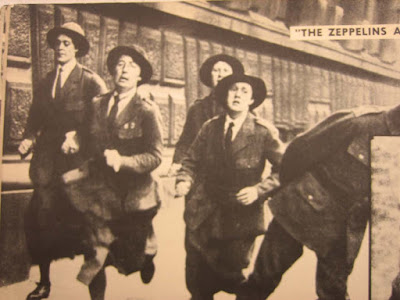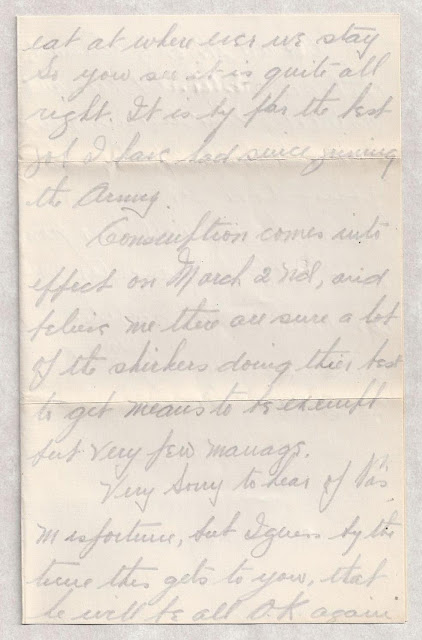I have no letters preserved in the Charley Bailey collection from the 21st of November 1915 to early January 1916. I wonder how he fared over Christmas this year?
And Wouldn't Charley be Amazed to know that Facebook has reminded all his followers that today is his birthday!! Born to Jennie and Charley Bailey 123 years ago in Brandon Manitoba, Canada on January 29th, 1892
Charley's mother, Jennie Howie was born on March 8, 1872, also in Portage la Prairie, Manitoba. Her father, James, was 34 and her mother, Jane, was 36. Her mother died four months after Jennie was born. Coincidentally, Charley's dad died just two months after Charley was born.
My father; Jennie's grandson, remembered her recollecting seeing and hearing the Red River Carts going through town.
 |
Photos taken in Portage la Prairie in the 1880's
Settlers loaded all of their worldly possessions onto ox carts for the long, slow treck to their homesteads.
http://www.gov.mb.ca/rearview/averill/journal/rr-oxcart_photo.html |
This excerpt is from a fascinating history written in 1970 called
A HISTORY OF PORTAGE LA PRAIRIE AND SURROUNDING DISTRICT By Anne M. Collier
Reading it gave me a real taste of what life would have been like for Charley and his mom in those early years and I am always drop jawed when I read Canadian history; how recent this all was and how far we've come ~ and how fast.
From Anne Collier's book: On Portage la Prairie
1892 (the year Charley was born) was a time when great wheat fields, separated by threadlike
wire fences, were chequered with rows of stooks, where the grain
stood ready to be stacked when dried. Noisy binders moved around
diminishing squares of standing grain. Men in the fields stooked as
the sheaves fell from each binder. That was the year that there were two million bushels of grain
grown on the Plains and marketed in Portage la Prairie. Of this, the
bulk was wheat, with oats and barley coming second and third
respectively. Forty and fifty bushels to the acre for a whole farm was
not uncommon.
South of the town could be seen a line of trees - oak, ash, elm,
maple, cottonwood and poplar, outlining the course of the Assiniboine
River. Vast quantities of wood from these trees provided excellent
cord wood for home consumption, and for export to Winnipeg and
Brandon.
The outline of a prosperous town rose between the tracks and a
bayou of the Assiniboine River.
The Lake of the Woods Milling Co. in Portage was rated the
largest and best equipped mill west of Toronto. This firm shipped
flour by the carload lots to all points west as far as the Pacific Coast.
The oatmeal mill, the pioneer of its kind in Manitoba, ran day and
night in an attempt to supply the demand for that product.
Down by the Assiniboine River was the large Portage Paper Mill,
which manufactured all brands of heavy wrapping and building paper.
The plant of machinery originally cost $30,000. The capacity of the
mill was over five tons per day.
Much building was being done and planing mills were kept
constantly busy.
A couple of machine shops were doing a rushing business attending
to the repairs of about 75 steam threshing outfits, worth $150,000
which were operating on the Portage Plains. Thirty tractors and
portable steam engines were counted around the Watson Bros.
Machine Shop one day!
Implement dealers could scarcely keep up with the demand for
plows, patent stackers, seed drills, mowers and selfbinders.
All lines of business were well represented. Four banks did the
business of the town and of the farming community. Two large
breweries supplied the demands in that line of business, covering a
large territory. A brickyard was operating east of the town.
The
semi-weekly Liberal, The Review and The Saturday Night were the
eyes of Portage.
The registry system had divided Manitoba into four large
districts, and with the introduction of the Torrens system a staff of
from ten to fifteen registrars and clerks were employed in the Land
Titles Office.
The big brick central school, which cost $35,000 furnished, was
found to be inadequate to accommodate over 700 school children and
ward schools had to be opened.
Six religious denominations had churches. The Roman Catholics
were just completing a large new one, and the Methodists had
erected a big brick edifice in 1891 at a cost of $13,000.
Town streets were lighted by arc lights, and over 1300 incandescent
lamps were in use in public and private homes.
The telephone boasted an exchange list of 100 subscribers.
Smith Curtis and George H. Webster, C. E., prepared plans for
the damming of the Assiniboine River, for the purpose of providing
water-power for electric and manufacturing purposes. The scheme
involved the flooding of what was known at that time as "The
Slough," to convert it into a beautiful lake.
Across the river, a valuable section of country was opened up
by the N.P. & M.R., and settlers were flocking into it. It was
adapted to mixed farming especially, and possessed great stores of
valuable wood and shelter groves, along with rich native grasses,
easily cut and cured into the best of hay.
It wasn't only these things that attracted people to the Portage
Plains. The whole plain was under laid at a depth of from 8 to 20 ft.
with a water-bearing strata of sand that was easily tapped, thus securing a plentiful supply of pure water.
In dry seasons the sand strata supplied moisture to the black loam,
and in wet seasons it gave under drainage.
We will end the 1892 narrative with a touch of humor. A paper
of that year contained an advertisement which said, "WANTED -
a smart boy to be half outside and half behind the counter."
HIGH BLUFF was known as the "Nairn District" in the very early days. (This is where Jennie and Charley Bailey Sr. lived when Charley Bailey was born. It's about 8 miles NE of Portage la Prairie) Because of a high bluff or grove of trees, which rose conspicuously
out of the surrounding woods the area was given the
name 'High Bluff.'
Archdeacon Cochrane can be credited, not only for starting the
first white settlement at Portage la Prairie, but also for the confidence
he inspired in pioneers to cast their lot in the area which circled
his settlement. High Bluff came within this circle. High Bluff Village was a pretty important little place in those
days.
The first steam-powered elevator was built by Mr. John Dilworth
in the early 1880's (two horse-powered ones having been built
and used previously). It was rebuilt after being consumed by fire
in 1897 and Andrew Forsythe, who founded the Forsythe Grain
Co., built a grain dryer to be used in conjunction with the new one.
The head office for the Company at the time was High Bluff.
Before the railway went through mail was picked up by a carrier
who met the stage coaches conveying it to Old High Bluff. Later,
a room in Mr. Coxsmith's home became a post office. Another room
in his home became the first telephone office. At that time there
was a bank (the Bank of Nova Scotia), three stores, three blacksmith
shops, a livery stable, two implement shops, a boarding house,
a billiard hall and barber shop, a grist mill, and the services of a
doctor.
Sports and entertainment added zest to the life of the community.
Skating, curling, lacrosse and baseball were the main sports, and
concerts, house parties and garden parties the main entertainments.
Two professional ball players who got their basic practice in
High Bluff were Melville Jackson and Clarke Metcalf. The High
Bluff baseball team won the provincial title in 1924.
High Bluff played an important part in patriotic efforts in both
of the World Wars. The many men and boys who made the Supreme Sacrifice is the greatest proof of this. High Bluff gained in stature
because of them, but was made poorer by their absence.
Due to progress in modes of transportation, speedy communication
and advanced education, another little village is living in its
glorious memories of the past. The history of any village contains
an element of nostalgia.
The lengthy excerpt above is from:
A HISTORY OF
PORTAGE LA PRAIRIE
AND SURROUNDING DISTRICT
By Anne M. Collier
Happy 123rd Birthday Charley Bailey
Lots of folks thinking of you today!



















































